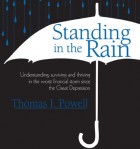In a recent WSJ piece, Edward Pinto links the housing bubble to liberal advocacy groups like Acorn. The argument goes something like this: government polices aimed at increasing home ownership forced entities like Freddie Mac to lower lending standards and acquire large amounts of risky mortgages.
“The flood of CRA and affordable-housing loans with loosened underwriting standards, combined with declining mortgage interest rates—to 5% in 2003 from 10% in early 1991—resulted in a massive increase in borrowing capacity and fueled a house price bubble of unprecedented magnitude over the period 1997-2006.”
Groups like Acorn lobbied for “innovative and flexible” lending practices and helped “ignite” the housing bubble. Acorn is a large political advocacy group that pushes issues for low-income earners. Pinto links Acorn’s efforts to increase homeownership to the recent housing bubble and financial crisis.
Does he have a case? First we should recognize his bias. Mr. Pinto was chief credit officer at Fannie Mae from 1987-1989. Not surprising then that he would defend his former professional affiliation. However, a massive increase in loans made without due diligence over the past 15 years is an undeniable cause for collapse. As Pinto points out, loans made with less than 5 percent down increased from 9 percent in 1991, to 29 percent in 2007. Default rates also increased. Government-sponsored enterprises’ high-risk loans faced a 10.3 percent default rate.
Bankers and regulators should have known better. Barney Frank, Chairman of the Financial Services Committee, argued to switch the focus from home ownership to rental properties. This would have isolated the mortgage industry from reckless lending practices. He made his argument back in 2002.
Lack of due diligence is the real crime here. Why did the nation’s largest mortgage lenders ignore a fundamental principle of finance? The answer to that question will help us avoid another meltdown. You cannot blame a poverty-advocacy group for a banker’s lack of competence. Yes, policies aimed at increasing homeownership failed. But that is only part of the puzzle. Financial innovation, de-regulation, derivatives, Glass-Steagall, China and Fed policy where other factors.
Though I agree with Pinto’s analysis, blaming community groups for advocating loose lending standards is a bit harsh. Bankers need to take some responsibility.
Tom Powell








